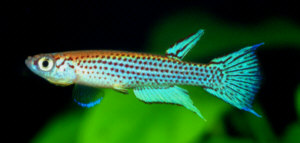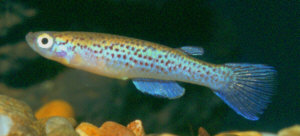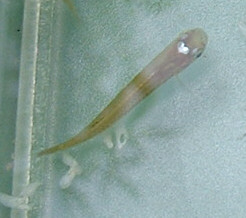Fenerbahce formosus (Huber 1979)
|
Fenerbahce formosus Male. Photo Courtesy of Ed Pürzl |
Fenerbahce formosus Female. Photo Courtesy of Ed Pürzl |
| Meaning of Name |
formosus = beautiful. |
||
| First Description |
|
||
| Size |
3 cm. The holotype measured 17·3 mm. |
||
| Meristics |
|
||
| Karyotype |
SG 0·0%, n = 12, 12 arms & 13·7% (Scheel, BKA newsletter No.186, February 1981). Scheel considered this 'the most specialised karyotype so far disclosed among killifish of the Old World'. |
||
| Sub-Genus |
|
||
| Group |
|
||
| Synonyms |
|
||
Populations
|
|||
| Type Locality |
|
||
| Distribution |
|
||
| Habitat |
Inhabits a large swampy area in the lower part of the Sangha River subdrainage which drains into the Congo River. They were collected in shallow water. Huber reported there habitat preference to be
small rivers & the edges of larger ones. They have been observed
to be a schaoling sp. with up to hundreds of individuals in mid-water
areas near the banks but not at the waters surface. Occupied water depth
being 30-120 cm deep (dry season). Also reported from marshy streams.
Sympatric sp. include Aphyoplatys duboisi,
Epiplatys chevalieri, Ep.multifasciatus
group members, A.splendidum &
members of the A.elegans group. |
||
| Distinguishing Characteristics |
Dorsal fin set far back down the body. Bright
blue body background. General shape. No other sp.(currently known) could
be confused with Adamas formosus. |
||
| Colour/Pattern Variability | Can be quite variable even within a population as reported by Huber in BKA newsletter No. 249, May 1986. Some locations have no red spots at all & location JH 78 / 110 had no colouration of any description, being described as 'pepper & salt'. | ||
| History |
Collected by J.H.Huber on a collecting trip to
Congo Brazzaville in 1978. To describe this new sp. Huber erected a
new genus which he named Adamas
in 1979. Alain Dubois in an article in Zootaxa 1757: 66–68 (2008)
brought to the attention that the generic name of Adamas
was preoccupied by Adamas Malaise,
1945 (Hymenoptera). Collected by Buytaert in 1981 on the island of Mbamou in the Zaire River. |
||
| Breeding Notes |
In BKA newsletter No.196, December 1981 Ian Sainthouse
gave the following info. Montiel & Woeltjes in KCF Killi Revue sheet
65 reported them as being a semi-annual as the eggs were observed to
undergo periods of diapause. |
||
| Diameter of Egg | Very small. | ||
| Remarks |
Sensitive to water pollution so regular water
changes are advised. |


